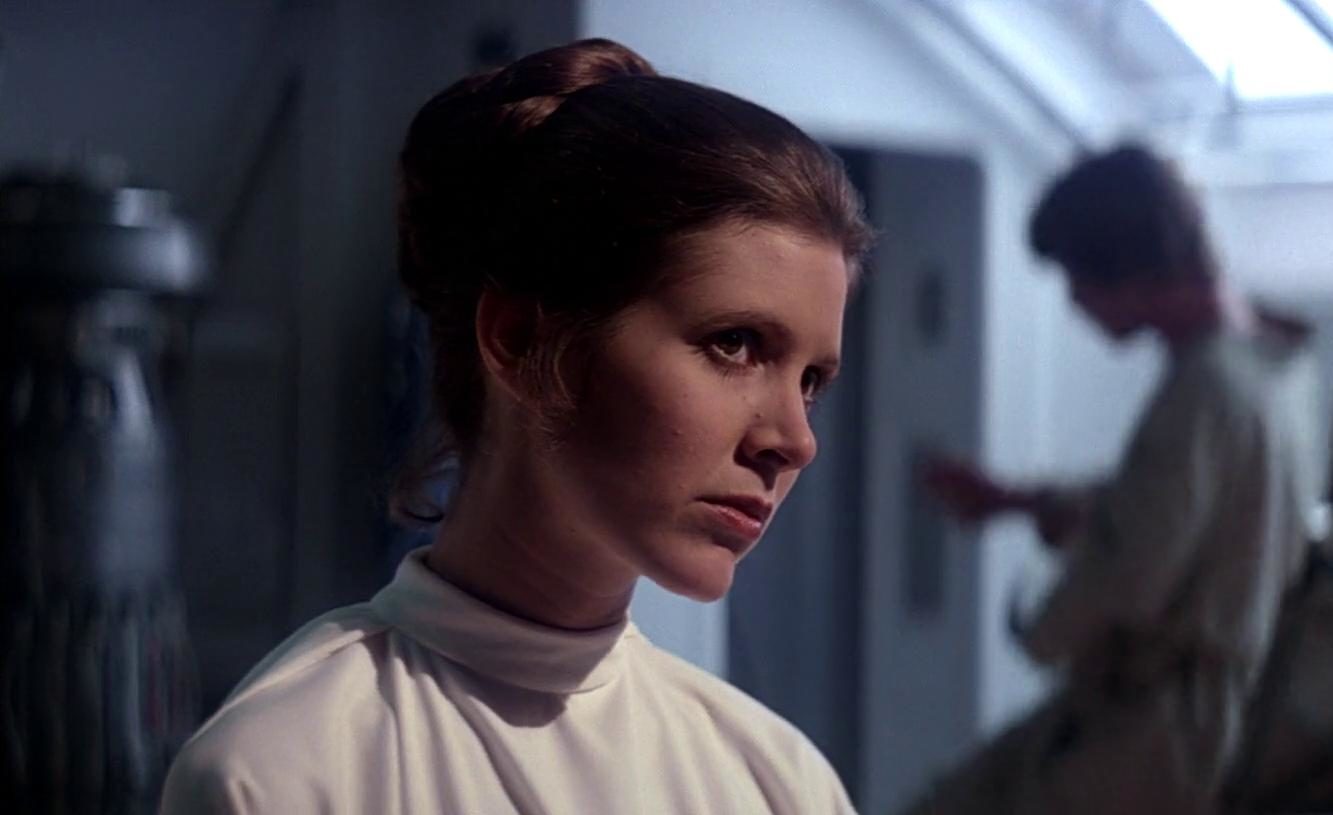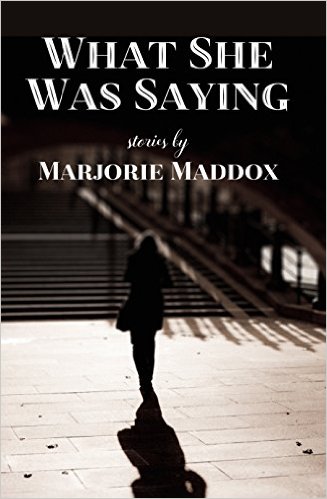Trapped in quarantine purgatory, my partner and I, like two stereotypical GenXers, decided to escape to a galaxy far, far away. As we watched all three Star Wars trilogies, I was transported to the mellow days of the 70s in fog-drenched Monterey when my hair shone naturally golden and my sister and I frolicked in the ice-plant, climbing twisted scrub oaks in our front yard, part of the army base where my helicopter-flying father was stationed. I was five-years-old when George Lucas released his space odyssey Star Wars — that lightning in a bottle of space dust forever entwined in my consciousness. Though I was too young to remember viewing the first film, at some point, I developed my first girl-crush on an intergalactic princess with cinnamon buns for hair.
For Halloween in 1977, my mom sewed the only handmade costume I ever wore, winding my hair into two blonde swirls. We argued then about space-princess fashion. I could not recall Princess Leia having a hood, but later I realized mom was right. The hood shielded her identity as she skulked in space shuttle corridors, protecting top-secret rebel plans to destroy the evil Empire. This princess was righteous. With her chic 70s white gown and cocked blaster, was it any wonder that I was instantly smitten?
In those early days, Star Wars meant playing in a backyard with a sensitive, tow-headed boy named Timmy. I liked Timmy’s house because he had just about every Star Wars action figure imaginable along with Han Solo’s notorious spaceship, the Millenium Falcon. He also owned Luke Skywalker’s Tatooine land speeder, my favorite space vehicle. Because I was a girl, I had to go to Timmy’s to indulge my fixation; Star Wars toys were meant for boys. But Timmy would often cry, growing weary and bored with this abundance long before I would. He would disappear inside the house, my imagination stretching solo in his backyard, lost and whizzing through the universe among dusty planets with Leia, my chosen avatar.
When I had my tonsils removed, my parents presented me with my very own Luke Skywalker and Princess Leia action figures, quickly followed by a 12-inch Leia doll that appeared under the Christmas tree. She was built like a tank with bright red lipsticked lips. It didn’t take long for her coiled hair to unravel in the violence of play.
Dim in memory’s fractured sense of time, my great-grandmother passed away and we departed on a long flight to New York for the funeral. Emerging from the mourning, what lingered from that trip was a brief outing to see the just released sequel, The Empire Strikes Back. We stood in a snaking line around the theater. Waiting, I stared up at the looming movie poster at Luke riding an Arctic alien creature and in the foreground, dashing Han Solo clutched – in a classic Hollywood romantic embrace – a relenting Leia in wending braids. I left the film dazzled, transformed in the wake of this tragic space spectacle.
After my parents split up briefly and I moved with my mom and sister to my grandmother’s in the South, someone gave me a tiny Yoda action figure for my birthday party at a roller rink. The little green guru came complete with a robe and plastic orange snake draped around his neck. Though I had new jeans wound with a stretchy gold belt, which made me feel older and cooler, I thrilled in secret at this nod to my Star Wars affinity, gone dormant. I found unlikely comfort in a reptilian talisman. It accompanied me to Germany soon afterward, where I existed as a military dependent, a child alien in a foreign land, reunited with my dad.
Returning to the states three years later, I re-entered my homeland in the early 80s an awkward tween complete with bad hair, braces, and spindly legs that had outgrown my body. Stuck in a sweltering summer in tidewater Virginia, my father’s last military assignment, I found temporary relief in a packed theater escape to the Redwood-forested planet of Endor. I was old enough then to realize the jokes were corny and those cuddly Ewok creatures were gratuitous. But there again was that princess, blasting away Imperial Storm Troopers on a speedy hot-rod before the enemy gave away the rebels’ daring plans to dismantle a deflector shield. And, how vile that this clever woman, who could pass as a bounty hunter and rescue Han Solo encased in carbonite, should wind up in a gold bikini enslaved to a slobbery alien slug. Again, after the credits rolled through a darkened theater, I blinked into the bright sun.
And then at some point, I lost the braces, headed to college and graduate studies, moved away, and settled into a career. In short, I grew up. The Star Wars trilogy had concluded and Princess Leia faded away with other childish things.
Then I turned thirty. Once George Lucas released the highly anticipated three films of the Star Wars prequels, my resistance loosened, and I duly made my way back to the theater. Inferior films all, they failed to move me. Critics cited the overabundant CGI effects and clunky writing, but for me it came down to this: the lack of a wise-cracking, blaster-packing princess.
But, as chance would have it, I also happened upon Postcards from the Edge, the early writing of Carrie Fisher, the actor forever chained to the iconic Princess Leia role. Her biting wit captivated me, so I followed its unrelenting circles over the years through her subsequent semi-autobiographical books. Vicious and wry in self-deprecation, her writing spared no ugly truth. She was simply brilliant. Surviving drug addiction and electric shock therapy, she endured the vicissitudes of bipolar disorder. Truly, the actor’s life proved as difficult as being outmanned and outgunned in an intergalactic war against a fascist regime.
But the past, especially when it’s a nostalgia-tinged cash cow, has a way of staying unburied. After getting married, we had just moved into our first apartment in a hippie neighborhood on Cleveland’s east side. Standing on a stepladder to store shoes on the top shelf of a closet one day, I noticed a child-sized shoebox stuffed in the far dusty reaches, I assumed accidentally left by the former tenants. Opening the box, I expected to see Buster Brown’s. Instead, a treasure trove of Star Wars action figures from all three original films lay crammed together. The thrill of childhood coursed through me. They were all here: R2D2, Lando Calrissian, C3P0, Chewbacca, Darth Vader, Han Solo, Luke Skywalker, Yoda, the Ewoks. And the best part? Not one, but three different versions of Princess Leia: I could not believe my luck.
So, why exactly does a space princess still take up space in a grown woman’s mind? Sure, the heroine withstood torture and strangled her oppressor. She kept her sights on something bigger than herself: a mission, a Force binding us all, even when she didn’t understand it. But she was so much less than this, too. She was not good. She had a temper; she refused to follow orders; she barked quips at the man who presumed to rescue her; she emasculated her brother, noting his short stature. She never armored her heart, allowing herself to fall for the n’er-do-well smuggler, believing in his goodness, all the while knowing it was unwise. And when a primitive race of teddy bear-creatures welcomed her into their tribe, she let down her hair and joined them. This cinematic messiness just feels truthful in all its weirdness.
Princess Leia — but really, Carrie Fisher, who breathed her to life on screen — showed us the contradictions within which women coexist in both their inner world and outer space. The outward show of it might suggest capitulation to expectations: a virginal, sexy damsel in distress. But Carrie Fisher’s secret weapon remained, always, hard-bitten truth-telling. The gold bikini awakened all her feminine nightmares but, as she made clear in subsequent interviews, she didn’t like it. She enjoyed killing the mobster that enslaved her. As she herself said, then she went backstage and took off the bikini. And sometimes, when asked to shill for the franchise, she delivered unabashed profanity-laden resistance. She refused to stay within the archetypal lines on or off stage.
It was glorious to see Carrie Fisher in the recently released final Star Wars trilogy, back in the role that birthed her in our collective imagination. But it also unsettled me. It became her swan song. A silver-haired military general and grieving mother, she rolled her eyes and heaved sighs in the direction of impulsive fly-boys. Although she embodied an earth-mother knowingness, this too felt like a let-down, another type to entrap her. What do you do with a confounding woman who refuses to lay down her weapons? Perhaps pin her with the star of a general, but only if she remains unsexed and maternal.
I’m sure women from other generations don’t see Carrie Fisher’s Princess Leia with the same fervor and reverence I do. Maybe it’s the timing. A young, impressionable girl, I grew up in an era when women were either idolized as sex objects or glorified as mothers. In my life, I have felt pressured to embody both and came out neither. I can’t remember anything in between. We did not see women on the big screen then as heroes, particularly if they were going to crack wise and refuse to stay within the confines of feminine constructs. Nowadays, young girls see ample examples of the female warrior in comic book movies and no shortage of foul-mouthed, messy figures of pop female empowerment. Then again, there’s a whole industry dedicated to fame, broadcasting nothing more than materialism and heavily filtered sexiness. Maybe we have not come all that far from a galaxy far, far away.
Carrie Fisher’s untimely passing meant we never got to see the version of the final film’s chapter that would have placed Leia’s narrative front and center, the ultimate hero. Instead, she dies a martyr of the Resistance. This perplexed me. But as I had just rewatched this final installment of the saga, the world tilted on its axis in our parallel universe when resolute jurist Ruth Bader Ginsberg passed away. On the fateful day the news broke, a bereft stranger posted something on social media that stopped me cold. “We’ve lost our General Organa,” she wrote. Her cry echoed in chambers deep within me, too. Our rights as we know them hang a mystery between the scales. But mortality does not snuff the stuff of legend. It was Carrie Fisher, after all, who had quipped: “Take your broken heart, make it into art.”Justice remains a moving target, a constant revolution, even when evident only in celluloid science fiction planets, dimly lit and distant.
I read once that J.J. Abrams, director of two films from the most recently released final trilogy, named in an interview his favorite Star Wars image: a melancholic vision of the boy hero, Luke, early in the first film. Drenched in the fading light of two setting Tatooine suns, he surveys the horizon, longing for an elusive future yet awaiting him.
When trapped sheltering in place, I revisited the films and chose my own favorite. At the end of The Empire Strikes Back, Han Solo has been captured, his fate uncertain; and Luke has lost his hand and his innocence, having reckoned with the evil in his father as also himself. But the figure that transfixes me here in this scene is Leia gazing out a window, not at the stars but — as I imagine — into darkness. Though standing next to Luke and their loyal droids, Leia looks small, alone, aggrieved.
As women, we navigate traps real and imagined, resurfacing, tempting, even manacling us if we’re not vigilant. Sometimes the attempt is downright comical or alternately unspeakable and grim.
But even enveloped in a bombastic space opera, this woman appears calm, elevated in her yearning. While she might seem lost, something else is at play here: a mature, hard-fought awareness — it, too, a force, a cosmic certainty all its own, surrounded though it may be by nothing but seeming endless emptiness.
Photo at the top of the page is of late actress Carrie Fisher in her role as Princess Leia. Photo from: https://i.imgur.com



